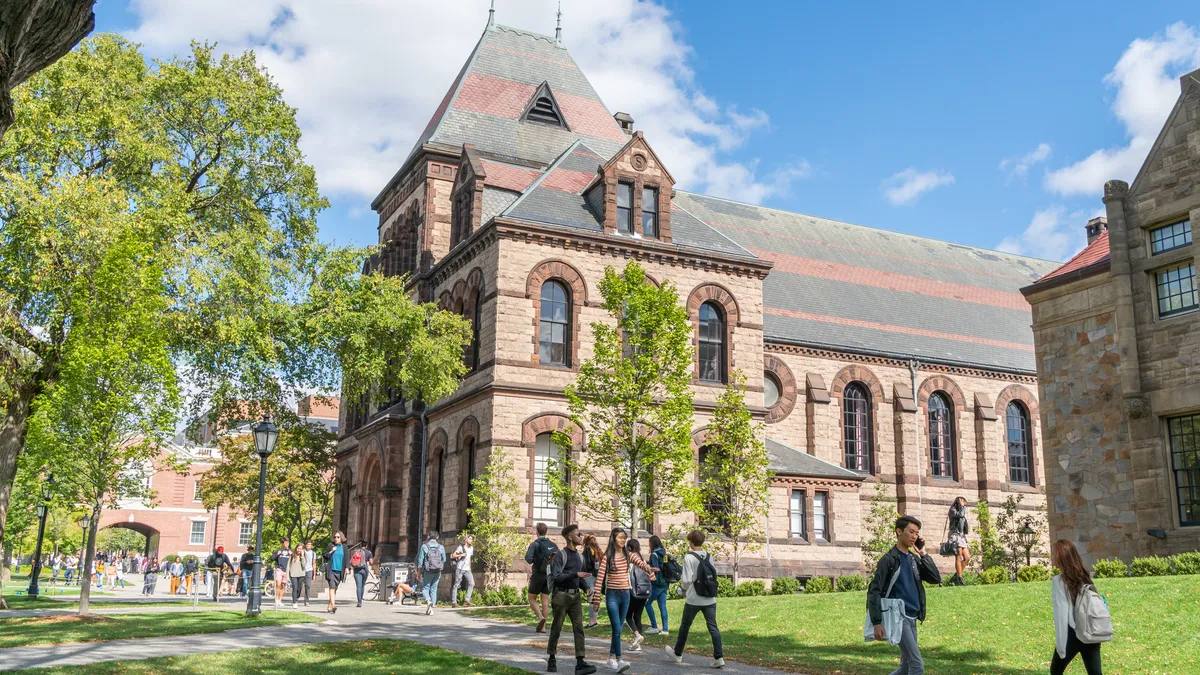In April, Dartmouth College announced an eye-catching figure to make its campus more sustainable, an investment amounting to half a billion dollars.
How the Ivy League university plans to actually lessen its impact on the planet is considerably less eye-catching. In fact, few around campus might have a chance to physically see the changes.
That’s because much of the spending will go into an overhaul of the campus’s facility heating infrastructure, moving it from a steam-based to a hot-water system.
“Hot water doesn't seem sexy or innovative,” said Josh Keniston, senior vice president of capital planning and campus operations at Dartmouth, who’s overseeing the institution’s energy transition. “It actually is a much more flexible technology than steam.”
The hot-water system Dartmouth is building out includes numerous distribution points, including a thousand underground bore holes — meaning the infrastructure is literally unseen.
The distributed nature of the system also doesn’t require centralized heating infrastructure. Instead, the college can use a variety of heating methods, such as electric heat pumps and solar powered heat pumps. It can even use water heated up in the New England summers and stored underground until winter, when it’s needed. All that allows for multiple approaches on energy.
The transition to the hot-water system — which replaces aging infrastructure already in need of an overhaul — means a 20% gain in efficiency.
“You lose so much energy when you're distributing via steam,” Keniston said. And that energy savings can help offset the investment costs over the years to come.
The infrastructure revamp is part of an effort to reduce emissions on campus 60% by 2030, and entirely 100% by 2050. It’s all tied in with a broader effort on campus meant to incorporate research, academics and the wider community.
For fiscal 2022, the institution reported about 58,500 metric tons of greenhouse gas emissions. It says it is on pace to meet most of its long-term emissions goals, though acknowledges it might not hit its 2025 target of lowering carbon emissions to 38,414 metric tons.
The $500 million Dartmouth is spending represents roughly a quarter of the institution’s overall capital improvement plan, according to Keniston.
Along with the transition to a hot-water system, it includes other energy efficiency measures like improving building enclosures. It also provides funds for adding non-combustion technologies such as geo-exchange boreholes, large-scale heat pumps and solar energy, for electricity as well as hot water generation.
The spending represents the largest investment focused on sustainability in the institution’s history, Dartmouth President Sian Beilock wrote in an April letter to campus.
“We acknowledge that our past efforts around campus decarbonization have come up short,” Beilock said in the letter. “Our new, much more aggressive goals are designed to help us lead in campus sustainability — especially in more rural cold-climate locations.”
Where the emissions are: heating, electricity, conferences
Dartmouth is just one college among thousands in the U.S. And it’s a wealthy one, with $1.4 billion in annual revenue and $11.7 billion in assets. Meanwhile, many others are trying just to balance their budget or even stay open.
While the higher ed sector might represent only a relatively small share of U.S. emissions, it still has roughly 4 million employees and over 18 million students who consume energy and resources. And on many campuses, there are plenty of areas to cut emissions, including at institutions that don’t have the resources of Dartmouth.
Perhaps around a quarter of higher ed institutions are leading the way on sustainability efforts, according to Julian Dautremont, director of programs with the Association for the Advancement of Sustainability in Higher Education.
“The other three-quarters is a lot more iffy,” Dautremont said. “I’m sure they’re doing some recycling, I’m sure they’re doing some energy conservation. So it's not like they're not doing anything. But it's a really wide disparity.”
Among the largest sources of colleges’ emissions are their own power and heating infrastructure — such as Dartmouth’s heating system — as well as their electricity purchases.
Stationary utilities — which include on-campus fossil fuel-burning infrastructure — account for 35.8% of colleges’ total average emissions, according to Sophie Mason, senior account manager for planning services at facility intelligence firm Gordian. Purchased electricity and indirect utilities account for another 32.8% of the 2023 emissions inventory tracked by Gordian.
The bustle of university life also comes with a sizable emissions footprint. Commuting among colleges’ employees and students represents 11.8% of average emissions, while other travel — which includes academic and leadership conferences — makes up another 11.5% of emissions.
Much of the effort to date to reduce climate emissions has centered on electricity purchasing.
Power purchase agreements, or PPAs, are one of the key strategies colleges have used to lower its footprint, Dautremont said.
PPAs provide institutions with long-term contracts for electricity sourcing and can focus on green energy sources. Groups of colleges can also take advantage of them. For example, nine institutions in North Carolina and Pennsylvania are collaborating on a PPA tailored to offset each consortium member’s current energy use and support a solar power project in Kentucky.
With PPAs relatively common, the frontier for emissions reduction now, Dautremont said, is in campus heating systems. That is where Dartmouth is putting its money.
Sustainability on a budget
But colleges have plenty of other potential tools to reduce their energy and environmental footprints — and that don’t require half a billion dollars in capital spending.
Mason and Duncan Ketel, planning services account manager at Gordian, pointed to temperature controls as an easy way to save on energy. That means ramping down the intensity of heating in the winter and cooling in the summer.
Avoiding emissions altogether is one of the most important things colleges can do. That could mean renovating existing buildings, and making them more efficient in the process, Mason said. Renovations are especially preferable to new constructions from an emissions standpoint when older, less efficient buildings stay in use even after new ones are built.
Reducing purchasing of things like paper and printer — and thereby cutting indirect emissions — is also a way to lower an institution’s carbon footprint, Dautremont noted. He also suggested eliminating trays in campus dining halls could lighten footprints by reducing food waste and the emissions around food production and preparation that come with it — and all at essentially no cost to the institution.
Reducing car commuting and employee travel would also have an impact on campus emissions. Travel for conferences and other events and meetings fell during the pandemic, though it has been trending back up in the years since 2020, Mason noted.
But cultural and structural obstacles stand in the way at many colleges.
“There's maybe some opportunity to travel less — attend conferences virtually or remote meetings for reaching out to prospective students or alumni,” Mason said. “That is seen by the universities, in a lot of cases, as the lesser option. That travel, that face-to-face, is really important to them.”
As for commuting, any effort to get students and employees to commute more by bicycle or bus depends in large part on the municipal infrastructure in the university’s hometown. But even tinkering around the edges such as through outreach on carpooling can have an impact.
“If I used to drive alone and now I carpool with three of my classmates, that's a shift. And that's at zero cost to [universities] other than their employees’ time to do outreach,” Ketel said.
Perhaps one of the most important tools, though, is in the organizational approach to sustainability.
When possible, don’t view sustainability in a silo — instead, find “the connections and overlaps to other areas that there already is traction to invest into,” Mason said, pointing to areas like deferred maintenance and research, where capital spending might have dual purposes.
At Dartmouth, a change toward thinking about investments in smaller chunks helped reframe what was possible, Keniston said.
For instance, instead of a wholesale change to its heating methods — it had previously considered a biomass plant to replace No. 6 fuel oil — the shift to hot water allows it to tackle chunks of its heating infrastructure at a time.
“Giving yourself permission to take small steps that add up over time for us led to a different set of technologies,” Keniston said. “It's also helped us give us some flexibility in terms of how we manage the construction and how we manage the finances. If something happens in the economy, and we have to put a pause, we're not going to have stranded assets.”



















